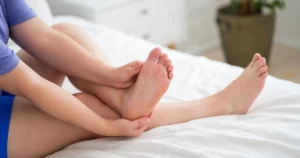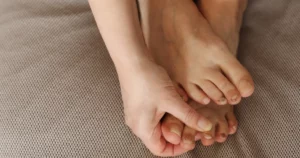
Table of Contents
If your child’s walk looks a little different, with their feet turning in or out instead of pointing straight ahead, you’re likely feeling a mix of concern and confusion. Is it something they’ll outgrow? Should you be worried about long-term effects? You’re not alone. In-toeing and out-toeing are common pediatric foot conditions, but they’re often overlooked or dismissed as normal.
The truth is, early signs of children’s foot pain, gait abnormalities, or unusual walking patterns shouldn’t be ignored. While some cases are harmless and self-correcting, others may benefit from intervention, especially if the issue causes discomfort, affects mobility, or impacts your child’s confidence.
At Integrity Foot & Ankle Associates, we provide compassionate and thorough care for families dealing with these concerns. Here’s what you need to know about in-toeing, out-toeing, and other pediatric foot conditions in Lorain, OH.
What Are Pediatric Foot Conditions (In-Toeing and Out-Toeing)?
“Pediatric foot conditions” is a broad term used to describe foot and gait-related concerns that arise in children. These include structural, functional, and developmental issues that may impact how a child walks, plays, or grows.
Two of the most commonly seen conditions are:
- In-Toeing (commonly referred to as “pigeon-toed”): When the toes point inward while walking or running.
- Out-Toeing: When the toes point outward instead of facing straight ahead.
These gait patterns are often caused by variations in the development of bones and muscles in the hips, thighs, knees, or feet. Although many children outgrow them, some continue to experience complications, ranging from toe walking and balance issues to long-term discomfort or uneven wear on joints.
Parents should be especially attentive if the child complains of children’s foot pain, tires easily, or struggles with physical activities. Understanding these signs is the first step in seeking effective pediatric foot care.
Benefits of Pediatric Foot Care
Seeking early care for pediatric foot issues isn’t just about correcting how a child walks; it’s about supporting their overall development and confidence. Here’s how proactive care makes a difference:
- Comfort and Pain Relief: Reduces or eliminates discomfort caused by abnormal gait patterns or pressure on joints.
- Improved Mobility: Helps children walk, run, and play with better coordination and endurance.
- Boost in Confidence: Kids often become more socially engaged when they feel physically secure and capable.
- Prevent Future Complications: Treating early helps avoid chronic issues like flat feet in kids, knee pain, or joint misalignment.
- Peace of Mind for Parents: Knowing your child is supported by a qualified foot and ankle specialist for children can ease long-term worry.
If left unchecked, conditions like in-toeing or out-toeing can contribute to complications later in life, making early evaluation a wise investment in your child’s future, so don’t hesitate to contact our team at Integrity Foot & Ankle Associates for expert guidance and care.
Who Is This Best For?
Pediatric foot care is suitable for a wide range of children, from toddlers just learning to walk to teens struggling with sports injuries or gait imbalances. Here’s when you should consider booking an evaluation:
- Your child’s feet point inward or outward when they walk.
- You notice frequent tripping or stumbling.
- Your child walks on their toes or avoids placing heels on the ground.
- Complaints of foot, knee, or hip discomfort during play.
- A visible difference between one leg or foot and the other.
- Family history of foot conditions or developmental delays.
Every child develops at their own pace, but when signs persist beyond expected milestones, a consultation with a foot and ankle specialist for children can bring clarity and confidence.
What to Expect (Process, Timeline, Results)
Addressing pediatric foot conditions involves a thoughtful process focused on personalized care and age-appropriate solutions.
Pre-Treatment Evaluation
Your first step is a comprehensive exam with a pediatric podiatrist. They’ll assess walking patterns, muscle tone, range of motion, and foot alignment. Imaging, such as X-rays, may be used in some cases to rule out structural concerns.
Treatment Options
Based on the findings, treatment may include:
- Observation and Monitoring: For mild cases expected to resolve naturally.
- Custom Orthotics: Shoe inserts to support alignment and reduce discomfort.
- Stretching and Physical Therapy: Exercises to improve muscle strength and gait mechanics.
- Bracing: Temporary support for foot or leg positioning.
- Surgical Intervention (rare): Reserved for severe, non-correcting cases.
Recovery and Results
Most children respond well to conservative care. Improvements in gait and posture may begin within weeks of starting treatment. Consistency and follow-up are essential to ensure your child’s development stays on track.
With early intervention, many kids avoid long-term complications and return to normal activities with ease and confidence.
FAQs and Common Myths
Will my child outgrow in-toeing or out-toeing?
In many cases, yes. However, persistent symptoms, pain, or imbalance may require evaluation. It’s best to monitor and seek guidance if symptoms don’t improve with time.
Is in-toeing caused by bad shoes?
No. It usually results from the way the bones and muscles develop, not footwear. Proper shoes can support comfort but won’t correct underlying alignment issues alone.
Are treatments like orthotics safe for kids?
Yes. Orthotics are custom-made and designed specifically for growing feet. They provide gentle, targeted support for foot alignment.
What age should I be concerned about foot issues?
Concerns can arise as early as toddlerhood. If your child is walking oddly or expressing pain, don’t wait, as early detection improves outcomes.
Does toe walking always mean a problem?
Not necessarily, but consistent toe walking beyond age 2–3 can signal developmental concerns and may require evaluation or toe walking treatment.
Helping Kids Walk with Comfort and Confidence
Childhood should be a time of movement, exploration, and play, not discomfort or worry about walking differently. If you’ve noticed signs of in-toeing, out-toeing, or other walking irregularities, it may be time to speak with a specialist.
At Integrity Foot & Ankle Associates, we offer compassionate, knowledgeable care for a wide range of pediatric foot conditions. Whether your child needs monitoring, orthotics, or more targeted intervention, we’re here to help them walk more comfortably and confidently.
Schedule your child’s foot evaluation today to get expert insight into your child’s foot health and ensure they’re on the right path for healthy development.




